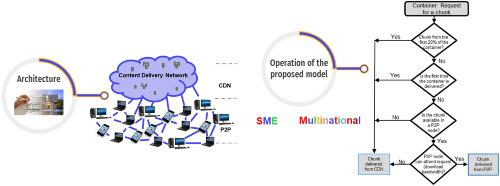当前位置:
X-MOL 学术
›
Int. J. Netw. Manag.
›
论文详情
Our official English website, www.x-mol.net, welcomes your feedback! (Note: you will need to create a separate account there.)
A cost-efficient QoS-aware analytical model of future software content delivery networks
International Journal of Network Management ( IF 1.5 ) Pub Date : 2020-08-31 , DOI: 10.1002/nem.2137 Beatriz Otero 1 , Eva Rodríguez 1 , Otilio Rojas 2, 3 , Javier Verdú 1 , Juan José Costa 1 , Manuel Alejandro Pajuelo 1 , Ramón Canal 1
International Journal of Network Management ( IF 1.5 ) Pub Date : 2020-08-31 , DOI: 10.1002/nem.2137 Beatriz Otero 1 , Eva Rodríguez 1 , Otilio Rojas 2, 3 , Javier Verdú 1 , Juan José Costa 1 , Manuel Alejandro Pajuelo 1 , Ramón Canal 1
Affiliation

|
Freelance, part-time, work-at-home, and other flexible jobs are changing the concept of workplace and bringing information and content exchange problems to companies. Geographically, spread corporations may use remote distribution of software and data to attend employees' demands, by exploiting emerging delivery technologies. In this context, cost-efficient software distribution is crucial to allow business evolution and make IT infrastructures more agile. On the other hand, container-based virtualization technology is shaping the new trends of software deployment and infrastructure design. We envision current and future enterprise IT management trends evolving towards container-based software delivery over hybrid content delivery networks (CDNs). This paper presents a novel cost-efficient QoS-aware analytical model and a hybrid CDN–peer-to-peer (P2P) architecture for enterprise software distribution. The model would allow delivery cost minimization for a wide range of companies, from big multinationals to SMEs, using CDN–P2P distribution under various industrial hypothetical scenarios. Model constraints guarantee acceptable deployment times and keep interchanged content amounts below the bandwidth and storage network limits in our scenarios. Indeed, key model parameters account for network bandwidth, storage limits, and rental prices, which are empirically determined from their offered values by the commercial delivery networks KeyCDN, MaxCDN, CDN77, and BunnyCDN. This preliminary study indicates that MaxCDN offers the best cost-QoS trade-off. The model is implemented in the network simulation tool PeerSim and then applied to diverse testing scenarios by varying company types, number and profile (either, technical or administrative) of employees, and the number and size of content requests. Hybrid simulation results show overall economic savings between 5% and 20%, compared to just hiring resources from a commercial CDN, while guaranteeing satisfactory QoS levels in terms of deployment times and number of served requests.
中文翻译:

未来软件内容交付网络的具有成本效益的 QoS 感知分析模型
自由职业者、兼职、在家工作和其他灵活的工作正在改变工作场所的概念,并给公司带来信息和内容交换问题。在地理上,分散的公司可以通过开发新兴的交付技术,使用软件和数据的远程分发来满足员工的需求。在这种情况下,经济高效的软件分发对于允许业务发展和提高 IT 基础架构的敏捷性至关重要。另一方面,基于容器的虚拟化技术正在塑造软件部署和基础设施设计的新趋势。我们设想当前和未来的企业 IT 管理趋势会朝着基于容器的软件交付通过混合内容交付网络 (CDN) 发展。本文提出了一种新颖的、具有成本效益的 QoS 感知分析模型和一种用于企业软件分发的混合 CDN 对等 (P2P) 架构。该模型将允许从大型跨国公司到中小企业的各种公司的交付成本最小化,在各种工业假设场景下使用 CDN-P2P 分发。在我们的场景中,模型约束保证了可接受的部署时间并将交换的内容量保持在带宽和存储网络限制以下。实际上,关键模型参数考虑了网络带宽、存储限制和租赁价格,这些参数是根据商业交付网络 KeyCDN、MaxCDN、CDN77 和 BunnyCDN 提供的值凭经验确定的。这项初步研究表明 MaxCDN 提供了最佳的成本与 QoS 权衡。该模型在网络模拟工具 PeerSim 中实现,然后通过不同的公司类型、员工数量和资料(技术或管理)以及内容请求的数量和大小应用于不同的测试场景。混合模拟结果显示,与仅从商业 CDN 中租用资源相比,总体经济节省了 5% 到 20%,同时在部署时间和服务请求数量方面保证了令人满意的 QoS 水平。
更新日期:2020-08-31
中文翻译:

未来软件内容交付网络的具有成本效益的 QoS 感知分析模型
自由职业者、兼职、在家工作和其他灵活的工作正在改变工作场所的概念,并给公司带来信息和内容交换问题。在地理上,分散的公司可以通过开发新兴的交付技术,使用软件和数据的远程分发来满足员工的需求。在这种情况下,经济高效的软件分发对于允许业务发展和提高 IT 基础架构的敏捷性至关重要。另一方面,基于容器的虚拟化技术正在塑造软件部署和基础设施设计的新趋势。我们设想当前和未来的企业 IT 管理趋势会朝着基于容器的软件交付通过混合内容交付网络 (CDN) 发展。本文提出了一种新颖的、具有成本效益的 QoS 感知分析模型和一种用于企业软件分发的混合 CDN 对等 (P2P) 架构。该模型将允许从大型跨国公司到中小企业的各种公司的交付成本最小化,在各种工业假设场景下使用 CDN-P2P 分发。在我们的场景中,模型约束保证了可接受的部署时间并将交换的内容量保持在带宽和存储网络限制以下。实际上,关键模型参数考虑了网络带宽、存储限制和租赁价格,这些参数是根据商业交付网络 KeyCDN、MaxCDN、CDN77 和 BunnyCDN 提供的值凭经验确定的。这项初步研究表明 MaxCDN 提供了最佳的成本与 QoS 权衡。该模型在网络模拟工具 PeerSim 中实现,然后通过不同的公司类型、员工数量和资料(技术或管理)以及内容请求的数量和大小应用于不同的测试场景。混合模拟结果显示,与仅从商业 CDN 中租用资源相比,总体经济节省了 5% 到 20%,同时在部署时间和服务请求数量方面保证了令人满意的 QoS 水平。



























 京公网安备 11010802027423号
京公网安备 11010802027423号